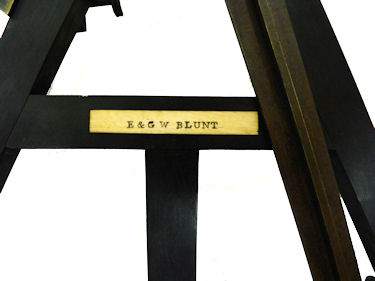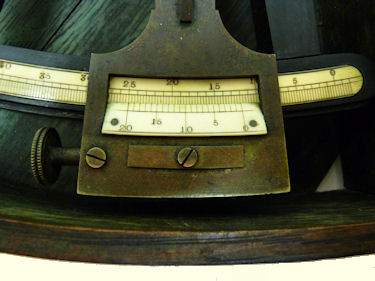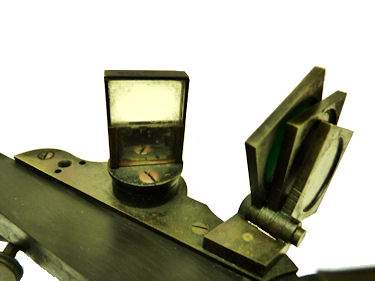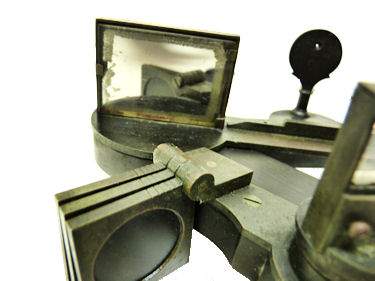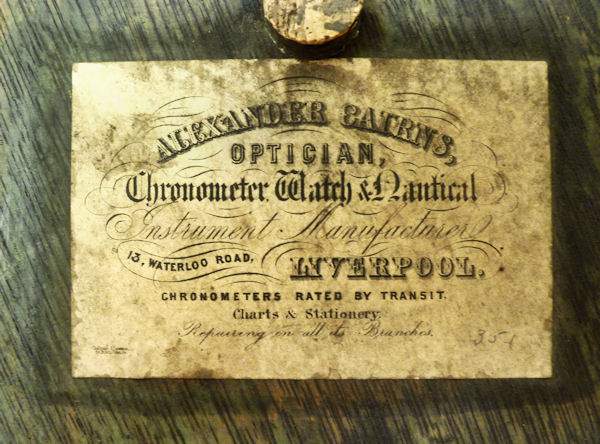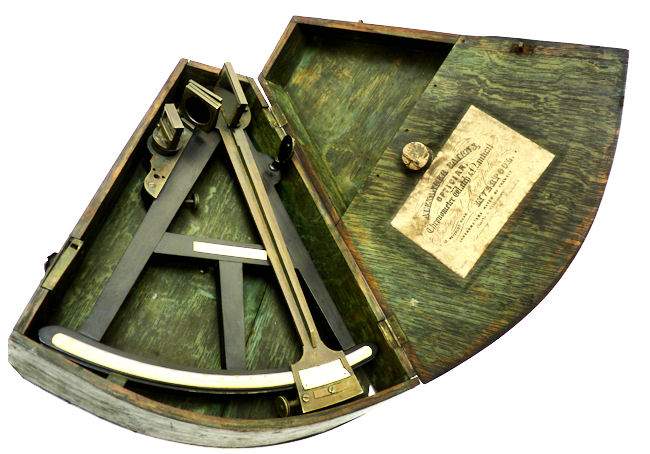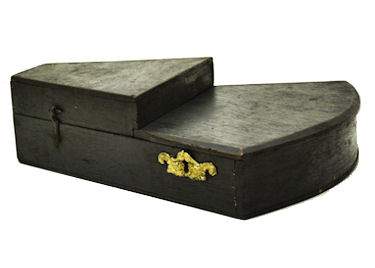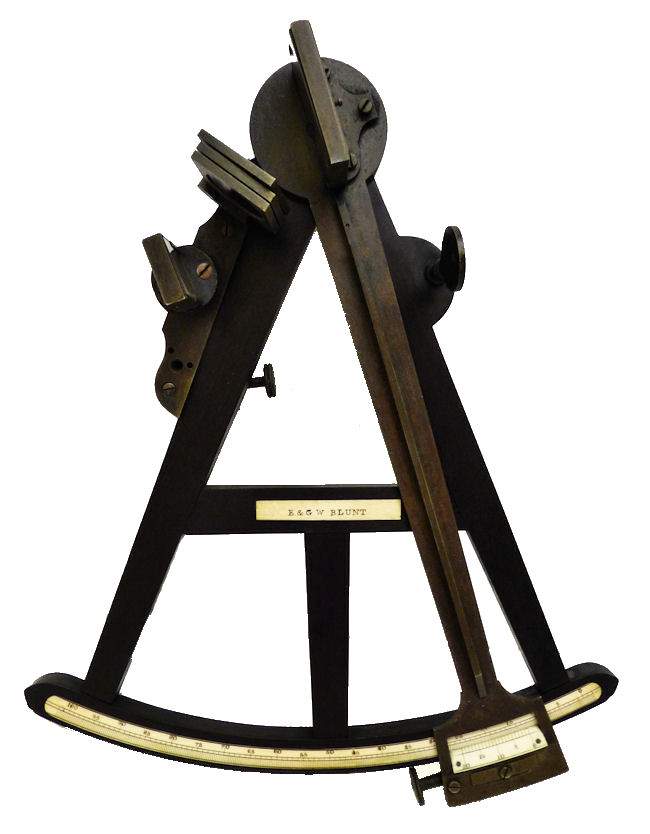
PRESENTED is a mid 19th Century “E.
& G.W. BLUNT” antique sextant with ebony frame, ivory graduated arc and vernier, and bronze machinery that is in
remarkable condition, with a wonderful patina of age. The arc measures from – 5 to plus 105 degrees.This
carefully crafted instrument has a brass index arm with rib measuring 12 5/8 inches long dating it to 1850
or earlier. The frame has a width of 10 1/4 inches at the arc. It is fitted with the early style ivory vernier
scale, reading from right to left from 0 to 20 arc minutes, a peep sight with a single hole, three sun shades. and an index
and horizon mirror. All the hardware has developed a wonderful dark patina over the last 162 years. Typical of the
maker, the arc and vernier are sharply engraved. The central piece of ivory fitted on the cross bar is imprinted, “E
& G W BLUNT”.PROVENANCE: From a New England collection, possibly that of a museum.
What may be an Accession Number, 89.00.18020 appears on an ivory pad on the back of the frame and also on
the bottom of the case.
Museum accession number?
to someone who will appreciate its fine workmanship and condition. It is becoming increasingly difficult to
find navigation instruments of this age, quality and condition
PEDIGREED HISTORY: Edmund March Blunt opened a chart and instrument
store in New York in 1811. His sons, Edmund and George William Blunt, trading as E. & G. W. Blunt, opened a similar store
in 1824.“Edmund Blunt was born in Newburyport, Massachusetts in 1799 and died in Brooklyn, New York in 1866.
When his father retired in 1822, the store was first taken over by his son-in-law, William Hooker, then by Blunt’s sons, Edmund
and George William and the firm became E. & G. W. Blunt. George William Blunt was born in Newburyport in 1802 and
died in Brooklyn, in 1878.” Reference: Smart, Charles E. The Makers
Of Surveying Instruments In America Since 1700 Troy, New York: Regal Art Press. 1962In
the early days, most of these instruments were imported. An advertisement from 1837 states: “One of the firm is now
in England superintending the manufacture of Theodolites, Transit Instruments, etc.,–and any orders for Instruments
not now on hand, will be forwarded to him, and executed promptly.” The Blunt firm was also noted for publishing
a Nautical Almanac starting in 1850. In the mid-1850s, after having built a dividing engine, the Blunts advertised that
they could “divide Astronomical and Nautical Instruments to a degree of precision which they will guarantee to be equal
to the best of foreign make.” The firm, with its dividing engine, became Blunt & Nichols (in 1866), Blunt &
Co. (in 1868), Eckel & Imhoff (in 1872), and H. A. Kolesch (in 1885).This sextant predates the company name change of 1866, and the fine Alexander
Carins’ label in its case supports the 1850 date. Carins was a Liverpool, England optician, instrument maker who also
serviced instruments. They were active at 13 Waterloo Road until 1869.On August 4, 1871, equally
renowned John Bliss & Sons purchased the famous Blunt & Co. The combination lasted for 100 years more.
|
|
|
|
CONDITION SEXTANT: The instrument, its ivory name tag, its sharply struck
graduated arc,and its hardware are of the highest quality for this period. The three bronze legs are original.
All the machinery is original. There may be a second set of shades for the horizon mirror that is missing. The mirrors
are in much better condition than would be expected for their age. All in all, a very rare sextant in excellent
condition.THE CASE: The original stair stepped,
keystone case, darkly finished on the outside with a light greenish blue on the inside, is in good, solid condition after
years of service at sea. It has one age crack on the bottom and a small missing corner at the bottom right. There
is a purpose made, counter sunk, hole in its center. Missing is the key to the lock. The inside cover has an excellent
label of the Liverpool optician and instrument maker, Alexander Carins, that dates from 1869.
Carins Label of 13 Waterloo Rd, Ca 1869
An outstanding and important sextant
from a premier 19th Century American pedigreed instrument maker.
DIMENSIONS:
11“
x 22 mm
In case 4 lbs 4 ozWe also have this very unusual and important boxed
compass from the same maker. See https://landandseacollection.com/id618.htmlSCROLL DOWN TO GALLERY FOR ADDITIONAL PICTURES
QUALIFICATIONS: We are one of the few company’s still selling navigation
instruments that know anything about them. For purposes of judging whether Joel’s opinion counts, he was the editor
of the chapter on sextants of the 1977 Edition of “Bowditch”, The American Practical Navigator, NAVPUB 9; a member of the
U.S. Naval Academy Navigation Symposium Board, 1975 -1978; the author of a book on marine sextants, Cornell Maritime Press,1975,
and the founding president of Nautech Maritime Corporation which partnered with Tamaya of Japan in the introduction of the
MS 733 Spica, the MS 833, Jupiter, MS 933 Venus sextants and the famous NC-2 navigation computer, in the U.S. market. Joel
is a retired Master Mariner, and held a U.S. Navy “D” Qualification as a Senior Skipper – Oceans. For
six years he was a Varsity Offshore Coach at the U.S. Naval Academy.

